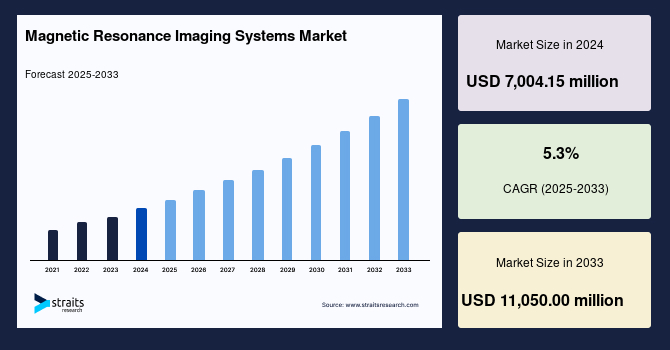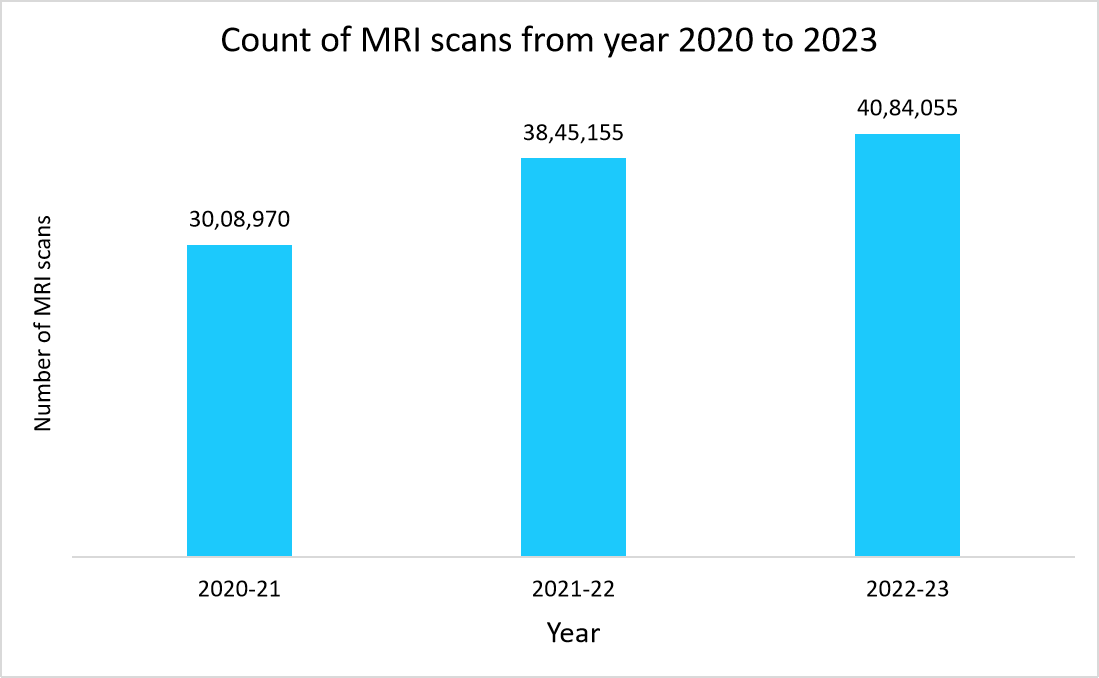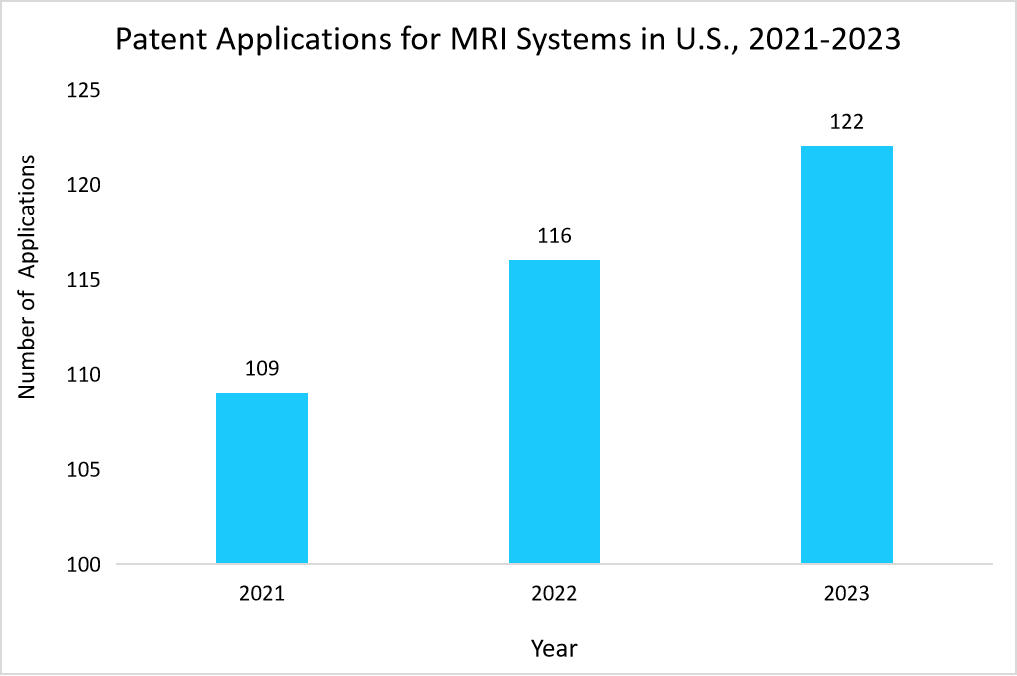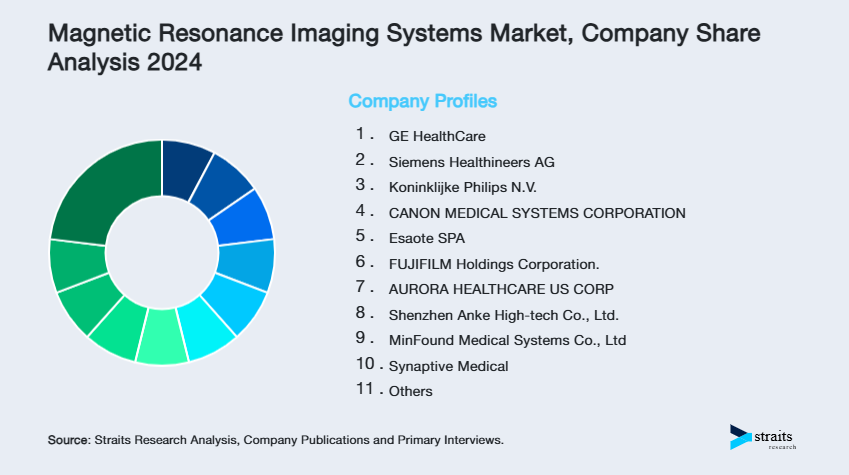Magnetic Resonance Imaging Systems Market Size
The global magnetic resonance imaging systems market size was valued at USD 7,004.15 million in 2024 and is projected to grow from USD 7,326.53 million in 2025 to USD 11,050.00 million by 2033, exhibiting a CAGR of 5.3% during the forecast period (2025-2033).
The major factors contributing to the growth of the global magnetic resonance imaging systems market include rapid technological integration, such as artificial intelligence (AI) into MRI systems in developed countries, increased field strength, and the emergence of helium-free systems. The AI integration in MRI systems has enhanced diagnostic precision and reduced scan times, boosting sales by 50%. Additionally, the expanding clinical applications of MRI in the diagnosis of chronic diseases such as cancer, cardiovascular conditions, and neurodegenerative disorders are further driving the need for MRI systems. Moreover, the use of portable and low-field MRI systems, the development of healthcare infrastructure, and increasing investment in public and private healthcare with an increasing geriatric population that are highly prone to chronic diseases requires the need for MRI scanning further propels the demand for MRI systems. Furthermore, increasing scanning volumes, advancements in radiomics, and the launch of advanced systems are enhancing imaging quality and speed, enabling broader adoption in outpatient and specialized care centers.
However, the growth of the market is restrained by notable factors such as High capital and operational costs in lower-income regions where funding is limited. The need for skilled radiologists and technologists is also a major challenge for the adoption of advanced MRI modalities. On the other hand, the market presents significant opportunities, such as innovations in helium-free technologies for middle income countries, lightweight MRI systems that are reducing installation and operational complexities.
Latest Market Trends
Shift from Hospital-Based Imaging to Outpatient Imaging
The magnetic resonance imaging systems market is witnessing a significant transition from traditional hospital-based imaging services to outpatient imaging centers. This shift is driven by the growing emphasis on cost-efficiency, patient convenience, and faster turnaround times. Outpatient centers typically offer lower-cost imaging solutions while maintaining high diagnostic quality, making them increasingly attractive to both patients and payers.
- For instance, companies such as RadNet in the U.S. have significantly expanded their outpatient MRI facilities, highlighting the market’s movement toward decentralized care.
This evolution not only reduces the burden on hospital infrastructure but also enhances accessibility for routine and elective imaging. As a result, the growing footprint of outpatient MRI centers is poised to reshape service delivery models, opening new growth avenues for imaging equipment manufacturers and service providers.
Growing Focus towards the Development of Helium-Free Mri Systems
Traditional MRI machines require large volumes of liquid helium for cooling superconducting magnets, but the scarcity and rising cost of helium have made this model increasingly unsustainable. In response, manufacturers are developing next-generation MRI systems with zero or minimal helium dependency.
- For instance, in February 2024, Koninklijke Philips N.V., leading the way of helium-free MRI technology, by installing over 1,000 of its virtually helium-free BlueSeal MRI systems worldwide. Such innovation reduces helium usage and makes MRI more sustainable, affordable and accessible.
- The Koninklijke Philips N.V., BlueSeal magnet, is 1.5T fully sealed magnet and requires only 0.5% of the helium of a conventional Philips MR system, which helps more patients in different locations to be benefited from these technologies and also provides best patient outcomes.
These advancements not only reduce installation and maintenance costs but also make MRI systems more accessible to facilities in remote or resource-limited settings. As the market embraces these helium-free innovations, it opens the door to broader global adoption, especially in emerging healthcare economies looking for reliable and environmentally responsible imaging solutions

To get more insights about this report Download Free Sample Report
Magnetic Resonance Imaging Systems Market Growth Factors
Growing Number of Mri Examinations Worldwide
The global expansion in the number of MRI scans is propelling the growth of the magnetic resonance imaging systems market, owing to rising awareness of early disease detection, improved diagnostic accuracy, and the expanding prevalence of chronic conditions such as cancer, neurological disorders, and musculoskeletal issues. Increasing number of MRI examinations in Canada signals the preference towards MRI as an imaging technique for disease diagnosis
- For instance, according to the National Institutes of Health (NIH), 2,214,157 publicly funded MRI examinations were performed in 2022-2023, which was a remarkable increase of 4.3% from 2019-2020.
- In addition, the graph below depicts the number of MRI scans being conducted in England from the year 2020 to 2023, which reflects each year’s increase in the count of MRI scans.

Source: NHS England
This growth in MRI examinations not only in Canada and England but throughout the world is resulting into the need for the deployment maximum MRI systems across the globe, thereby propelling overall market expansion.
Expanding Clinical Applications of Magnetic Resonance Imaging
Magnetic resonance imaging is increasingly being adopted across a broader range of clinical specialties, significantly expanding its role in modern diagnostics and patient care. Originally focused on neurological and musculoskeletal imaging, MRI is now widely utilized in cardiology, breast cancer screening, liver imaging, and functional brain mapping, among other areas.
- For instance, cardiac MRI is gaining prominence for its ability to non-invasively assess myocardial viability and detect congenital heart defects with high precision. Approximately 74% of private clinics in Argentina are installed with at least one cardiovascular magnetic resonance systems.
This broadening scope of clinical applications enhances the utility of MRI systems and drives greater demand from hospitals, specialty clinics, and diagnostic centers.
Market Restraining Factor
High Cost of Magnetic Resonance Imaging Systems
The widespread adoption of magnetic resonance imaging systems is limited with the high capital and operational cost. MRI machines, especially high-field and advanced models with functional or multi-parametric capabilities, often require investments ranging from hundreds of thousands to several million dollars. This expense not only includes the scanner itself but also extends to specialized shielding, installation, and ongoing maintenance.
- For instance, the cost of India’s first indigenous 1.5 Tesla MRI systems is approximately 6-9 crore, which further increases with the increasing Tesla units.
As a result, despite growing diagnostic demand, the high cost continues to restrict market penetration in cost-sensitive regions and delays technology upgrades in underfunded hospitals, thereby tempering the overall growth potential of the MRI market.
Market Opportunity
Development of Novel Rf Coils for Hyperpolarized Magnetic Resonance Imaging
The development of novel radiofrequency (RF) coils specifically designed for hyperpolarized MRI represents a cutting-edge potential in the market, aimed at remarkably enhancing image quality and functional imaging capabilities. Hyperpolarized MRI provides real-time metabolic information with exceptional clarity, particularly valuable in oncology, cardiology, and neurology.
- Researchers at institutions such as Stanford University have developed custom RF coils for carbon-13–based hyperpolarized MRI, allowing more precise imaging of tumor detection. These advanced coils are enabling researchers and clinicians to visualize biological processes at the molecular level, which was previously unattainable with traditional MRI.
As these innovations progress from research to clinical use, they are expected to unlock new diagnostic applications, thus expanding the technological scope and clinical utility of MRI systems in the years ahead.
Regional Insights
North America, the dominant region with a 38.60% market share, accounted for the majority of the magnetic resonance imaging systems market revenue, owing to strong healthcare infrastructure, well-established reimbursement schemes, and increasing prevalence of chronic conditions such as neurodegenerative disorders and cancers. Additionally, high adoption of advanced MRI systems, strong presence of leading medical device companies, and robust diagnostic imaging infrastructure further drive market growth in the region. Further, collaboration between manufacturers and hospitals facilitate the flow towards exchange of expertise and exposure to recently developed systems is reshaping the diagnostic imaging capabilities in North America.
- U.S.- The U.S. magnetic resonance imaging systems industry is experiencing strong growth driven by presence of leading U.S. based medical devices companies such as Hyperfine, Inc., and GE HealthCare is strengthening the country’s position in the global market by advancing MRI systems. Further increasing patent applications for MRI systems in U.S. indicates a strong approach towards research and development of novel technologies and launch of novel magnetic resonance imaging (MRI) systems in U.S. market.
- The graph below indicates the number of patent applications for MRI systems in U.S.

Source: World Intellectual Property Organization (WIPO)
Asia Pacific Magnetic Resonance Imaging Systems Market Trends
Asia Pacific region is anticipated to grow at fastest CAGR during the forecast period. This growth is driven by rising prevalence of chronic conditions such as cancer and cardiovascular problems, improving healthcare infrastructure, increasing government initiatives, and growing investments in research for developing whole-body MRI. Additionally, expanding access to advanced diagnostic imaging in emerging economies such as China and India is accelerating market growth in the region. Further, expanding cancer screening efforts for breast, cervical, colorectal, stomach, and lung cancer in the region is increasing the deployment of advanced MRI systems across the region.
- China – Magnetic resonance imaging systems industry in China is dominated by the high scale of domestic production and cost effectiveness of magnetic resonance imaging systems are driving market growth of magnetic resonance imaging systems market in China. The presence of key manufacturers such as Shenzhen Anke High-tech Co., Ltd and Shanghai United Imaging Healthcare Co., LTD and others in the region plays a vital role in cost effectiveness.
- For instance, in 2023, a domestically developed magnetic resonance imaging system was successfully mass-produced and implemented at Peking University Shenzhen Hospital.
Such innovation was led by researchers from the Shenzhen Institute of Advanced Technology, part of the Chinese Academy of Sciences (SIAT).
- India – In India, the rising number of government hospitals in India is propelling growth in the magnetic resonance imaging systems market by expanding access to diagnostic infrastructure.
- For example, according to the Government of India, the number of government hospitals increased from 12,807 in 2020–2021 to 13,915 in 2021–2022.
Such expansion along with increasing prevalence of chronic diseases reflects growing public investment in healthcare, which is expected to drive demand for advanced imaging technologies such as MRI to enhance diagnostic capacity and support broader healthcare delivery across urban and rural regions.
Europe Magnetic Resonance Imaging Systems Market Trends
- UK – UK market is rapidly growing owing to the increasing burden of brain tumors and focal epilepsy, which the demand for market for magnetic resonance imaging systems, especially for diagnostic and monitoring application, as the need for early and accurate detection has increased.
- For instance, as per the reported data of Brain Research UK, across 12,300 people are diagnosed with primary brain tumour every year, hence signifying the growing demand for MRI technology.
- Further, in March 2025, as per the article published in UKRI, around 360,000 people in UK suffer from the condition of focal epilepsy, which is also the sixth most common reason for hospital admission in UK. So, doctors at Addenbrooke's Hospital, Cambridge use ultra-high filed 7T MRI scanners, that offer detailed resolution of brain scans in patients with drug-resistant epilepsy, hence offering early detection as well as diagnosis of the disease.
Thus, high burden of brain disorders along with increasing number MRI scans throughout the country propels the demand for MRI devices for accurate diagnosis and monitoring of the condition.
- France- In France, the focus on the advanced paediatric MRI by establishing specialized platforms, presents as a significant propelling the market growth.
- For instance, Institut Robert-Debré du Cerveau de l’Enfant, focuses on the development of 7T MRI for children at the CEA Neurospin imaging centre. Coupled with dedicated medical imaging (3T MRI) and cognitive testing platforms, these initiatives will enhance early diagnosis and support personalized growth and development plans for children.
Such integrated approach advances high-resolution imaging systems in France, which drives innovation and improves paediatric healthcare outcomes.
Middle East and Africa Market Trends
- South Africa– In South Africa, investment in MRI education and deployment of accessible imaging technologies are building a skilled workforce and expanding operational capacity, enabling broader adoption of MRI devices in South Africa.
- For instance, Khomotso Motiang, a lecturer at Sefako Makgatho Health Sciences University, received the ISMRT Future Leaders Fellowship, supported by the Bill & Melinda Gates Foundation, to advance MRI training in underserved regions.
- Additionally, in June 2023, Hyperfine, Inc. partnered with ISMRM and the Gates Foundation to promote MR education and deploy its Swoop portable brain imaging system in LMICs, including South Africa, enhancing local neuroimaging capabilities and reducing access disparities.
Such initiatives support the operational readiness of healthcare facilities, improve access to skilled radiographers, and create favorable conditions for wider deployment and adoption of MRI systems across the country.
Latin America Market Trends
- Brazil– In Brazil, government led cancer screening programs for breast, cervical, and lung cancers are expanding the role of magnetic resonance imaging in Brazil. For instance, initiatives such as the Propulmão project integrate early detection strategies, including imaging, to improve outcomes. These efforts enhance diagnostic capabilities, particularly in underserved regions, thereby increasing the demand for advanced imaging technologies such as magnetic resonance imaging.
Type Insights
The market is segmented into open systems and closed systems. Closed systems segment accounted for largest magnetic resonance imaging systems market share, owing to owing to their higher image resolution and superior diagnostic capabilities compared to open MRI systems. These systems offer stronger magnetic fields, enabling more detailed and accurate visualization of internal organs and tissues. Despite some discomfort issues for claustrophobic patients, their widespread use in hospitals and diagnostic centers for complex imaging, especially in neurology and oncology has contributed to their continued market leadership.
Field of Strength Insights
The market is segmented into ultra high, high and low. High segment dominated the magnetic resonance imaging systems sector. This growth is driven by widely adoption of 1.5T-3T MRI systems for routine clinical applications and provide excellent image resolution for neurological, cardiovascular, and musculoskeletal imaging. Their versatility and cost-efficiency have made them a preferred choice for both advanced hospitals and mid-tier imaging facilities, contributing to their strong market position.
Application Insights
The market is segmented into neurology, oncology, cardiology, musculoskeletal diseases, gastrointestinal diseases and others. Oncology segment is anticipated to register fastest CAGR during the forecast period owing to rising global cancer burden and increasing use of MRI in cancer diagnosis, staging, and treatment monitoring. MRI's non-invasive and radiation-free imaging capability makes it particularly valuable in identifying soft tissue tumors and assessing metastasis. The growing emphasis on early detection and precision oncology, along with increasing investments in cancer research and screening programs, is driving the rapid expansion of this segment.
End User Insights
The market is segmented into hospitals, imaging centers and others. Hospitals segment is anticipated to register fastest CAGR during the forecast period owing increasing deployment of MRI systems in hospitals for instance, 68.1% of total MRI systems installed in hospitals in U.S., In addition, government investments for installation of new MRI systems, growing demand for hospital-based medical imaging procedures, and demand for new MRI systems in hospitals is further fueling the segment growth.
Company Market Share
Companies in the industry are focus on adopting key business strategies, such as product launches, acquisitions, and product approvals, to gain a strong foothold in the market.
Fujifilm Holdings Corporation.: An Emerging Company in the Magnetic Resonance Imaging Systems Market
FUJIFILM Holdings Corporation. is an emerging company in the market, owing to its advanced MRI systems portfolio and expanding market presence.
Recent developments
- In May 2025, FUJIFILM Holdings Corporation. strengthened partnership with the National Rural Health Association to improve access to medical imaging in rural communities.
List of key players in Magnetic Resonance Imaging Systems Market
- GE HealthCare
- Siemens Healthineers AG
- Koninklijke Philips N.V.
- CANON MEDICAL SYSTEMS CORPORATION
- Esaote SPA
- FUJIFILM Holdings Corporation.
- AURORA HEALTHCARE US CORP
- Shenzhen Anke High-tech Co., Ltd.
- MinFound Medical Systems Co., Ltd
- Synaptive Medical
- ASG Superconductors spa
- Neusoft Medical Systems Co., Ltd.
- FONAR Corp.
- Medonica Co. LTD
- HYPERFINE, INC.
- Time Medical Holding
- Shanghai United Imaging Healthcare Co., LTD
- SternMed GmbH
- Kangda Intercontinental Medical Equipment Co, Ltd
- Magnetica Ltd

To get more findings about this report Download Market Share
Recent Developments
- In May 2025, Koninklijke Philips N.V. collaborated with NVDIA to improve patient care in magnetic resonance with latest AI advances.
- In May 2025,Siemens Healthineers AG invested USD 150 million in new and expanded U.S. facilities.
Analyst Opinion
The magnetic resonance imaging systems market is experiencing robust growth globally, driven by rising chronic disease prevalence, expanding applications of MRI systems, and continuous innovation in field strength of MRI systems. Governments and private sectors are heavily investing in research and development, fueling the development of advanced MRI systems. Additionally, improved field strength, increasing patient awareness, and rising MRI scans for early detection are accelerating MRI systems deployment globally.
Report Scope
| Report Metric | Details |
|---|---|
| Market Size in 2024 | USD 7,004.15 Million |
| Market Size in 2025 | USD 7,326.53 Million |
| Market Size in 2033 | USD 11,050.00 Million |
| CAGR | 5.3% (2025-2033) |
| Base Year for Estimation | 2024 |
| Historical Data | 2021-2023 |
| Forecast Period | 2025-2033 |
| Report Coverage | Revenue Forecast, Competitive Landscape, Growth Factors, Environment & Regulatory Landscape and Trends |
| Segments Covered | By Type, By Field Strength, By Application, By End User, By Region. |
| Geographies Covered | North America, Europe, APAC, Middle East and Africa, LATAM, |
| Countries Covered | U.S., Canada, U.K., Germany, France, Spain, Italy, Russia, Nordic, Benelux, China, Korea, Japan, India, Australia, Taiwan, South East Asia, UAE, Turkey, Saudi Arabia, South Africa, Egypt, Nigeria, Brazil, Mexico, Argentina, Chile, Colombia, |
Explore more data points, trends and opportunities Download Free Sample Report
Magnetic Resonance Imaging Systems Market Segmentations
By Type (2021-2033)
- Open System
- Closed System
By Field Strength (2021-2033)
- Ultra High
- High
- Low
By Application (2021-2033)
- Neurology
- Oncology
- Cardiology
- Musculoskeletal Diseases
- Gastrointestinal Diseases
- Others
By End User (2021-2033)
- Hospitals
- Imaging Centers
- Others
By Region (2021-2033)
- North America
- Europe
- APAC
- Middle East and Africa
- LATAM
Frequently Asked Questions (FAQs)
Jay Mehta
Research Analyst
Jay Mehta is a Research Analyst with over 4 years of experience in the Medical Devices industry. His expertise spans market sizing, technology assessment, and competitive analysis. Jay’s research supports manufacturers, investors, and healthcare providers in understanding device innovations, regulatory landscapes, and emerging market opportunities worldwide.
Speak To AnalystAvailable for purchase with detailed segment data, forecasts, and regional insights.
Get This ReportOur Clients:










































